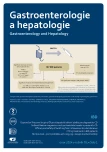Idiopathic hypereosinophilic syndrome with gastrointestinal involvement
Authors:
D. Husáková 1
; Š. Konečný 2
Authors‘ workplace:
Endoskopické oddělení, Nemocnice Milosrdných bratří, příspěvková organizace, Brno
1; Interní gastroenterologická klinika LF MU a FN Brno
2
Published in:
Gastroent Hepatol 2024; 78(1): 47-52
Category:
Digestive Endoscopy: Case Report
doi:
https://doi.org/10.48096/ccgh202447
Overview
Idiopathic hypereosinophilic syndrome (iHES) is a rare disorder with an unclear cause that is characterized by a persistent increase in the number of eosinophilic granulocytes in the peripheral blood and organ damage. The differential diagnosis of hypereosinophilia is broad – the cause may be primary (clonal), secondary (reactive – most often in the context of allergic, parasitic, autoimmune or malignant diseases), genetic (familial) or idiopathic (determined per exclusionem). This case report describes a patient with recurrent episodes of abdominal pain, ascites, and leukocytosis with hypereosinophilia, who underwent extensive examinations over the years, including two diagnostic laparoscopies. CT scans revealed abnormalities in the small bowel and stomach region, and histological and cytological examinations confirmed an increased number of eosinophils in the duodenal villi and eosinophilic ascites. Gastroscopy raised suspicion of eosinophilic esophagitis and stomach involvement, but this was not confirmed histologically. The ethiology of mild hepatopathy with elevated transaminases remains unclear, as the patient refused liver biopsy, repeatedly. After ruling out primary and secondary causes of hypereosinophilia, the idiopathic hypereosinophilic syndrome was diagnosed and corticotherapy was initiated with good clinical and laboratory outcome and normalization of eosinophil count.
Keywords:
ascites – eosinophilia – hypereosinophilia – hypereosinophilic syndrome
Sources
1. Novotný J. Hypereozinofilie. Transfuze Hematol Dnes 2021; 27(4): 278–282. doi: 10.48095/ ccta hd2021278.
2. Doubek M, Brychtová Y, Kissová J et al. Diferenciální diagnostika eosinofilie. Vnitř Lék 2014; 60(2): 21–27.
3. Valent P, Klion AD, Roufosse F et al. Proposed refined diagnostic criteria and classification of eosinophil disorders and related syndromes. Allergy 2023; 78(1): 47–59. doi: 10.1111/ all.15544.
4. Dispenza MC, Bochner BS. Diagnosis and Novel Approaches to the Treatment of Hypereosinophilic Syndromes. Curr Hematol Malig Rep 2018; 13(3): 191–201. doi: 10.1007/ s118 99-018-0448-8.
5. Shomali W, Gotlib J. World Health Organization – defined eosinophilic disorders: 2022 update od diagnosis, risk stratification, and management. Am J Hematol 2022; 97(1): 569–148. doi: 10.1002/ ajh.26352.
ORCID autorů
D. Husáková 0009-0001-7347-2880,
Š. Konečný 0000-0002-7709-3079.
Doručeno/ Submitted: 9. 10. 2023
Přijato/ Accepted: 26. 11. 2023
MU Dr. Dagmar Husáková
Endoskopické oddělení
Nemocnice Milosrdných bratří, příspěvková organizace
Polní 3 639 00 Brno
dagmar.husakova@nmbbrno.cz
Labels
Paediatric gastroenterology Gastroenterology and hepatology SurgeryArticle was published in
Gastroenterology and Hepatology

2024 Issue 1
- Metamizole at a Glance and in Practice – Effective Non-Opioid Analgesic for All Ages
- Possibilities of Using Metamizole in the Treatment of Acute Primary Headaches
- Metamizole vs. Tramadol in Postoperative Analgesia
- The Importance of Hydration in Wound Healing
- The Importance of Limosilactobacillus reuteri in Administration to Diabetics with Gingivitis
Most read in this issue
- Mirikizumab – the first anti-IL23 p19 antibody in ulcerative colitis therapy
- Methotrexate is the re-discovered drug for Crohn’s disease
- Idiopathic hypereosinophilic syndrome with gastrointestinal involvement
- Hidradenitis suppurativa, intestinal microbiome and SIBO – a comprehensive overview of the issue
